|
Paintings since the Renaissance in Europe are based on
realism. After the 19th century, a movement against the traditional
realism happened. But they transformed or abstracted it based on realistic
sketches. On the other hand, among Japanese artists, there were those who
designed concrete paintings that do not base on realism by designing
symbols of a shape like idol of a moral religion like animism or totemism
. Jiro Oyamada created an artistic character, such as a comic character,
and had a painter who gave the background a suitable background for the
character. Jiro Oyamada is one of them.
Jiro Oyamada was born in 1914 and
received academic art education at Imperial Art School. He encountered
surrealism there. But immediately after that World War II began, in an
environment where it became a scorched earth, he continued painting in
isolation. The person he draws is such a strange character as not to be
seen by humans. His painting space, which is made with the character as
the center, brings the viewer to reality realness goes to a different
space. We can distinguish his work at a glance by looking at the image of
the work. Not a few of his paintings have prominent personality. A strange
creature staring at here from the dark. Or a world of fantasies emerging
in fresh colors. The world he draws attracts those who see glimpses of
humor and kindness at times, even in surprising force.
For an introduction about Jiro
Oyamada from this link
■Borrow the style of religious paintings to embrace the devils
inhuman
Oyamada experienced World War II during his most auspicious
period in his twenties. When he experienced the extreme wartime
experience, he saw the human figure that he could not normally see. And in
the 1950s he became the age of his late thirties, he chewed up the intense
experience under wartime and sublimed it in painting expression. Many
people appreciate his works of this time as such. He borrowed a style of
traditional Christian religious paintings. Perhaps he needed the
universality of that style.
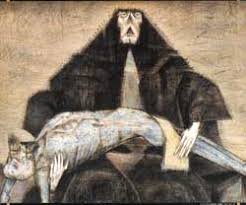 There is his painting "Pieta".Pieta is Italian, meaning mercy. The religious
painting Pieta is a kind of image of the Virgin and Child. Drawing in
Pieta is the figure of the Virgin Mary holding the crucifixion of Christ,
crucified and taken down from the cross. Many painters and sculptors are
making works based on Pieta as a motif. For example, the sculpture of St. Peter's Basilica, produced by
Michelangelo, is famous. There, Christ seems to feel dignity even
though it is a dead body. And Virgin Mary is a grieving mother who lost
her beloved child with a pure appearance, and at the same time her mercy
and compassion are transmitted. The sculpture by Michelangelo and "Pieta"
painted by Oyamada have the same pose and positional relationship between
Christ and Mary. Therefore, Oyamada follows the style of Pieta. However,
in Michelangelo's sculpture, it is composed of rounded curves as a whole,
the circle is warmth, the viewer imagines mercy and charity. On the other
hand, Oyamada's paintings are composed of straight lines, giving a viewer
of the angular gistogism impression as a whole. As this "Pieta" has a
strong sense of tension, the viewer of this painting feels a tragic
elevation and astonishment. Let's
actually look at Oyamada's "Pieta". The Virgin Mary located in the center
is an isosceles triangle. Christ lying parallel to the base of this
isosceles triangle, that is, horizontally. The composition of these two
people is a combination of a triangle and a straight line. She not only
has a triangle outline, it is composed of a combination of triangles. Her
mouth and nose are vertically aligned in an equilateral triangle. This
means that her mouth and nose are facing upwards. She is lifting the lower
jaw. It is facing upward, that is, looking up at the heavens. It is
elevation. However, her eyes There is his painting "Pieta".Pieta is Italian, meaning mercy. The religious
painting Pieta is a kind of image of the Virgin and Child. Drawing in
Pieta is the figure of the Virgin Mary holding the crucifixion of Christ,
crucified and taken down from the cross. Many painters and sculptors are
making works based on Pieta as a motif. For example, the sculpture of St. Peter's Basilica, produced by
Michelangelo, is famous. There, Christ seems to feel dignity even
though it is a dead body. And Virgin Mary is a grieving mother who lost
her beloved child with a pure appearance, and at the same time her mercy
and compassion are transmitted. The sculpture by Michelangelo and "Pieta"
painted by Oyamada have the same pose and positional relationship between
Christ and Mary. Therefore, Oyamada follows the style of Pieta. However,
in Michelangelo's sculpture, it is composed of rounded curves as a whole,
the circle is warmth, the viewer imagines mercy and charity. On the other
hand, Oyamada's paintings are composed of straight lines, giving a viewer
of the angular gistogism impression as a whole. As this "Pieta" has a
strong sense of tension, the viewer of this painting feels a tragic
elevation and astonishment. Let's
actually look at Oyamada's "Pieta". The Virgin Mary located in the center
is an isosceles triangle. Christ lying parallel to the base of this
isosceles triangle, that is, horizontally. The composition of these two
people is a combination of a triangle and a straight line. She not only
has a triangle outline, it is composed of a combination of triangles. Her
mouth and nose are vertically aligned in an equilateral triangle. This
means that her mouth and nose are facing upwards. She is lifting the lower
jaw. It is facing upward, that is, looking up at the heavens. It is
elevation. However, her eyes 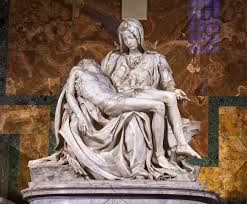 are represented by
what the downward triangles lie side by side. Although she is facing the
face to the sky, her eyes are turned downward. Here is the confrontation
relation. And the outline of her face is a downward triangle. Also, as I
said at first, her posture is an upward facing isosceles triangle. Here
her face and direction of the body are opposite, a conflict relationship
is born. She has a hierarchy of alternating triangles like nesting. In
other words, she has a multilayered structure in which upper and lower
binomial conflicts are layered. What is creating this confrontation is an
angular shape composed of straight
lines called
triangles. This makes the binomial confrontation more sharp. Furthermore,
in coloring, being confined to monochrome by the opposite two colors white
and black, it is fueling the confrontational relationship. The geometric
screen made up of triangles is static and massive as a whole, but the
tense feeling up to the stinging things with confrontation is stretched
among them. Here again,
let's focus on her face. Her face is multi-layered conflict. When we see
her face, I recognize a strong tension. Specifically, it is a strong
emotion that protrudes and those conflicting or confusion. From the strong
tension with conflict, expression of emotion such as intermediate calmness
or compassion can not be born. It is
possible to interpret such a figure of Virgin Mary as a figure caught in
despair such as grief, fear, anger, despair, curse against the threat of
my child Christ being deadly dead It is. She is drawn in black and is
depicted as a spooky person who can not be distinguished from men and
women. On the other
hand, let's move attention to the lying Christ. The appearance of this
Christ seems to be a dry mummy, and it is free from sanctity and sorrow.
Also, the head of Christ is drawn as a skeleton. The body is warped, legs
and hands are rigid. The Virgin Mary holds the Christ which began rigid
after death. It is not in a state that can hope for revival very much.
For example, as a figure that
received an abuse of crucifixion of
are represented by
what the downward triangles lie side by side. Although she is facing the
face to the sky, her eyes are turned downward. Here is the confrontation
relation. And the outline of her face is a downward triangle. Also, as I
said at first, her posture is an upward facing isosceles triangle. Here
her face and direction of the body are opposite, a conflict relationship
is born. She has a hierarchy of alternating triangles like nesting. In
other words, she has a multilayered structure in which upper and lower
binomial conflicts are layered. What is creating this confrontation is an
angular shape composed of straight
lines called
triangles. This makes the binomial confrontation more sharp. Furthermore,
in coloring, being confined to monochrome by the opposite two colors white
and black, it is fueling the confrontational relationship. The geometric
screen made up of triangles is static and massive as a whole, but the
tense feeling up to the stinging things with confrontation is stretched
among them. Here again,
let's focus on her face. Her face is multi-layered conflict. When we see
her face, I recognize a strong tension. Specifically, it is a strong
emotion that protrudes and those conflicting or confusion. From the strong
tension with conflict, expression of emotion such as intermediate calmness
or compassion can not be born. It is
possible to interpret such a figure of Virgin Mary as a figure caught in
despair such as grief, fear, anger, despair, curse against the threat of
my child Christ being deadly dead It is. She is drawn in black and is
depicted as a spooky person who can not be distinguished from men and
women. On the other
hand, let's move attention to the lying Christ. The appearance of this
Christ seems to be a dry mummy, and it is free from sanctity and sorrow.
Also, the head of Christ is drawn as a skeleton. The body is warped, legs
and hands are rigid. The Virgin Mary holds the Christ which began rigid
after death. It is not in a state that can hope for revival very much.
For example, as a figure that
received an abuse of crucifixion of 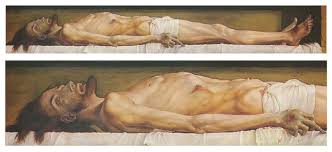 Christ 's corpse, the acts blurred
religious sufferings that totally carries on human suffering and original
sin and so on, Holbein' s He is not doing drawing dead bodies with real
true figures like" The Body of the Dead Christ in
the Tomb ". I thought about the reason for
that. He could not draw the dead body of Christ calmly like Holbein.
Compared to him, Holbein seems to be an objective observer. In other
words, Holbein keeps a distance to what Christ has encountered. That's
because Holbein is not a party. As mentioned at the beginning, Oyamada
experiences an extreme situation under wartime. At that time, he should
have been a bystander. Therefore, he was unable to be a bystander in the
extreme situation that he became an indelible figure of Christ. If he was
among the people throwing stones in Christ, would he be able to capture
the imageof Christ calmly? He also felt lied
about fearlessly that the Virgin Mary of "Pieta" embraced the Christ of
unrepentant appearance, with a mercy expression. For him, humans are
sublime, but there are places like animals at the same time. Even if
Christ and the Virgin Mary carry the sins of mankind, or that they have
given compassion to mankind, they are also human beings. So they should
also have aspects that are animal. He should be told to disgustingly in
the wartime that in extreme circumstances human animal aspects will
emerge. So, in the situation of "Pieta", if the Virgin Mary and Christ are
love or religious, it means that they are not human beings. That same
applies to Oyamada himself who draws "Pieta". So, he could not draw in
realism. When we look
at "Pieta" as a whole, we will talk about an unpleasant atmosphere or
impressions of strange power. As mentioned above, it is said that Oyamada
carefully designed the screen composition and drew "Pieta". Its contents
are as described above. Christ 's corpse, the acts blurred
religious sufferings that totally carries on human suffering and original
sin and so on, Holbein' s He is not doing drawing dead bodies with real
true figures like" The Body of the Dead Christ in
the Tomb ". I thought about the reason for
that. He could not draw the dead body of Christ calmly like Holbein.
Compared to him, Holbein seems to be an objective observer. In other
words, Holbein keeps a distance to what Christ has encountered. That's
because Holbein is not a party. As mentioned at the beginning, Oyamada
experiences an extreme situation under wartime. At that time, he should
have been a bystander. Therefore, he was unable to be a bystander in the
extreme situation that he became an indelible figure of Christ. If he was
among the people throwing stones in Christ, would he be able to capture
the imageof Christ calmly? He also felt lied
about fearlessly that the Virgin Mary of "Pieta" embraced the Christ of
unrepentant appearance, with a mercy expression. For him, humans are
sublime, but there are places like animals at the same time. Even if
Christ and the Virgin Mary carry the sins of mankind, or that they have
given compassion to mankind, they are also human beings. So they should
also have aspects that are animal. He should be told to disgustingly in
the wartime that in extreme circumstances human animal aspects will
emerge. So, in the situation of "Pieta", if the Virgin Mary and Christ are
love or religious, it means that they are not human beings. That same
applies to Oyamada himself who draws "Pieta". So, he could not draw in
realism. When we look
at "Pieta" as a whole, we will talk about an unpleasant atmosphere or
impressions of strange power. As mentioned above, it is said that Oyamada
carefully designed the screen composition and drew "Pieta". Its contents
are as described above.
 Let's see "Harituke (crucifixion)".He drew this as a subject of
the crucifixion of Christ. Some say that he painted himself. The cruciform
shadow behind it looks like a wall rather than a pillar of a tree. The
upper body of a man naked is drawn so as to stick to the wall. The man has
a thick chest and a large upper body is drawn. If we look at this
depiction, I think he is carrying a robust physical body. In his whole
body numerous large and small holes, scratches, black marks like blood
marks are drawn. Moreover, while the chest and abdomen are drawn largely,
the head is drawn extremely small. If we look at him, our gaze will focus
on the body, not the face. When we see ordinary figures, we focus on the
face of the person being drawn. However, in Oyamada's
"Harituke(crucifixion)" the face is small enough to make the expression
unknown and our gaze gathers towards the body. So, we leave a strong
impression on myriad scars and bloodstains drawn on his body. Let's see "Harituke (crucifixion)".He drew this as a subject of
the crucifixion of Christ. Some say that he painted himself. The cruciform
shadow behind it looks like a wall rather than a pillar of a tree. The
upper body of a man naked is drawn so as to stick to the wall. The man has
a thick chest and a large upper body is drawn. If we look at this
depiction, I think he is carrying a robust physical body. In his whole
body numerous large and small holes, scratches, black marks like blood
marks are drawn. Moreover, while the chest and abdomen are drawn largely,
the head is drawn extremely small. If we look at him, our gaze will focus
on the body, not the face. When we see ordinary figures, we focus on the
face of the person being drawn. However, in Oyamada's
"Harituke(crucifixion)" the face is small enough to make the expression
unknown and our gaze gathers towards the body. So, we leave a strong
impression on myriad scars and bloodstains drawn on his body. 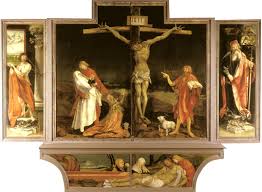 However, Oyamada does not directly depict the
miserable form in which he was abused. As a
reference, I would like you to see the part of "Isenheim Altarpiece" of the German painter Grünewald
during the Renaissance from the Middle Ages. Grünewart declares the
cruelty of the crucifixion of Christ, that it is a matter of wanting to
cover his eyes. When we see this altarpiece, we can imagine that the
Christian faith of the time when this was drawn was sharp. Christ drawn by
Oyamada Jiro is not outrageous miserable compared with the drawing by
Grüne Barthe and skillfully creates an atmosphere to emphasize the image
symbolically. For example, in the dark screen based on black, the body of
the crucified person is blue is the same color as the Christ of "Pieta".
Therefore, we speculate that this painting is connected to "Pieta". In
other words, it implies that this painting is part of a series that delves
into the essential aspects of human beings, being religious subjects. On
the other hand, he paints the body of Christ as a keynote with the subject
matter of crucified and cruelty Christ in this painting. He shows the dead
body 's black transparent with color in spite of the unbelievable thought
that the dead body is rotting and dark. For that reason he blended the
blue exquisitely into a bluish appearance and set the sharpness of the
black and darkness of the cross behind. Besides, in order to make use of
this exquisite color, he took the composition as geometrically designed.
In addition to that, he does not cause mechanical coldness by partly
destroying its geometric composition. On the other hand, he pays close
attention to keep a sense of tension. That is why when we see this
painting, we allow you to see the screen However, Oyamada does not directly depict the
miserable form in which he was abused. As a
reference, I would like you to see the part of "Isenheim Altarpiece" of the German painter Grünewald
during the Renaissance from the Middle Ages. Grünewart declares the
cruelty of the crucifixion of Christ, that it is a matter of wanting to
cover his eyes. When we see this altarpiece, we can imagine that the
Christian faith of the time when this was drawn was sharp. Christ drawn by
Oyamada Jiro is not outrageous miserable compared with the drawing by
Grüne Barthe and skillfully creates an atmosphere to emphasize the image
symbolically. For example, in the dark screen based on black, the body of
the crucified person is blue is the same color as the Christ of "Pieta".
Therefore, we speculate that this painting is connected to "Pieta". In
other words, it implies that this painting is part of a series that delves
into the essential aspects of human beings, being religious subjects. On
the other hand, he paints the body of Christ as a keynote with the subject
matter of crucified and cruelty Christ in this painting. He shows the dead
body 's black transparent with color in spite of the unbelievable thought
that the dead body is rotting and dark. For that reason he blended the
blue exquisitely into a bluish appearance and set the sharpness of the
black and darkness of the cross behind. Besides, in order to make use of
this exquisite color, he took the composition as geometrically designed.
In addition to that, he does not cause mechanical coldness by partly
destroying its geometric composition. On the other hand, he pays close
attention to keep a sense of tension. That is why when we see this
painting, we allow you to see the screen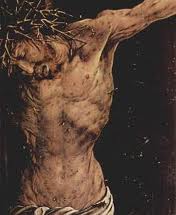 without turning
your eyes for a long time. without turning
your eyes for a long time.
 Let's look at the "Mukashi no Seijya(Old
Saint)". A man with limbs like a bird is sitting on a chair. He has a nail
inserted in both hands and is fixed to the ceiling with a string, both
feet are also fixed to the floor. It is like the appearance of Christ
crucified. However, his cheeks can be handled, beards are
all-you-can-grow, shin and toes are thin and bent like birds. Contrary to
the work title of the saint, he can not feel dignity nor dullness of love.
There is a liquor bottle behind him, he is a poor and oppressed man rather
than a saint. Moreover, it gives to those who see the comical impression.
Oyamada has this screen composed of a rectangle. Red is impressively added
in the dark color arrangement of black and blue. Unlike the dark serious
"Pieta" and "Harituke (crucifixion)", the impression of "Mukashi no
Seijya(Old Saint)" as a comical impression is that red is inserted in the
screen. In addition, the symmetry equilibrium is inevitably collapsed in
the screen composition by geometric figures. Therefore, the feeling of
tension in the screen composition is diminished. This is one reason why
this picture is producing a comical impression. We get a comical
impression because we are not immersed in this painting and are looking
calmly. In other words, we do not feel direct force like "Harituke
(crucifixion)" in this painting, but inspiration is
inspired. Let's look at the "Mukashi no Seijya(Old
Saint)". A man with limbs like a bird is sitting on a chair. He has a nail
inserted in both hands and is fixed to the ceiling with a string, both
feet are also fixed to the floor. It is like the appearance of Christ
crucified. However, his cheeks can be handled, beards are
all-you-can-grow, shin and toes are thin and bent like birds. Contrary to
the work title of the saint, he can not feel dignity nor dullness of love.
There is a liquor bottle behind him, he is a poor and oppressed man rather
than a saint. Moreover, it gives to those who see the comical impression.
Oyamada has this screen composed of a rectangle. Red is impressively added
in the dark color arrangement of black and blue. Unlike the dark serious
"Pieta" and "Harituke (crucifixion)", the impression of "Mukashi no
Seijya(Old Saint)" as a comical impression is that red is inserted in the
screen. In addition, the symmetry equilibrium is inevitably collapsed in
the screen composition by geometric figures. Therefore, the feeling of
tension in the screen composition is diminished. This is one reason why
this picture is producing a comical impression. We get a comical
impression because we are not immersed in this painting and are looking
calmly. In other words, we do not feel direct force like "Harituke
(crucifixion)" in this painting, but inspiration is
inspired.
似たような構思います。
■Comment to the extremely subjective Oyamada’s
paintungs
What I will mention below is my subjective image, not an
objective fact about Jiro Oyamada and it is not generally recognized about
him. I think that he is not a painter blessed with natural talent. He was
carrying a handicap of the body, so he had no choice but to choose his
profession within a limited range. For him, the painter is the result of
having no other choice.
からは、しています。
|







